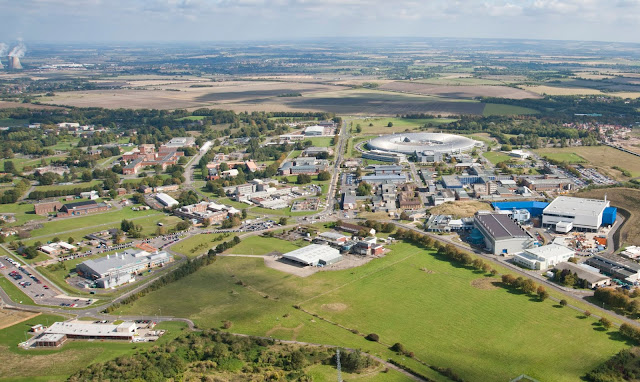Visit to the Science & Technology Facilities Council Library, by Stephen Gregory
Stephen Gregory has been a librarian at Welsh Government for more than 10 years. His previous experience was in healthcare, further and higher education and commercial legal practice libraries. Stephen is currently Secretary to the GIG Committee.
Visit to the Science & Technology
Facilities Council Library...
… Or a
chance to find out what polar bear fur, beetles’ wings, cultural heritage
artefacts, oh and pig snot, all have in common!
In
November 2019 GIG provided an opportunity to visit the STFC RAL Library and
ISIS Neutron and Muon Source. This was a fascinating visit, providing insights
into a world which many Government Knowledge and Information Management
professionals may be very unfamiliar with.
But with unfamiliarity comes the opportunity to learn, to compare and
contrast with your own experiences, and to take away ideas and improved
understanding.
 |
Rutherford Appleton Laboratory
(source: Wikimedia Commons)
|
Situated
close to the A34 near Didcot, Oxfordshire, Harwell Campus provides a southern
base for the STFC, as well as wide range other organisations, employing 5,500
staff and accruing £2 billion worth of facilities. This former RAF site now
specialises in providing a location and large scale facilities for cutting edge
science, space technology, medical research, laser and high performance
computing facilities.
Linda
Gilbert welcomed us to the centrally located Library, and provided a
fascinating overview of the history of Harwell Campus, its current provision,
and scope for continuing future development. A run-through of current library
services, staffing and facilities was provided, including a tour of the library
space and archive holdings. It was fascinating to hear how the library is
responding to the changing needs of its users, finding new ways to remain
relevant and a central hub for the site.
In an
increasingly digital world physical visits to libraries across many sectors are
declining. Users are still using our services but are doing so remotely through
online access or email enquiries. The Harwell Library recognise this challenge
and continues to do much to counter this digital effect. Library staff provide
induction tours for new staff, an important early point of contact to promote
the library and how it can make life easier for staff. Group training is also
offered, helping to upskill users to use online resources more effectively, or
to encourage the use of additional resources and an expanded repertoire of
search techniques. Linda stressed the importance of continuous advocacy for the
Library, including Library news pieces in the range of newsletters published
on-site, adding library promotional content to display screens, and using email
signatures to promote specific aspects of the service.
RAL Library
also does much to encourage visits to the Reading Room. The space provides a
welcoming environment for study and quiet reading, as well as a small meeting room,
and is open 24 hours each day. A frequently changing exhibition space provides
new reasons to visit every month, while also providing a useful buffer zone
lobby from the adjacent busy café into the quieter realms of the Library. Book
resources meet the core academic, research and management needs of staff, but are
also available to support health and well-being. The Library takes note of key national
health days or events, to maximise traction from wider publicity and awareness.
This is a common thread with libraries across many sectors, including those in
government. Harwell’s scientific, engineering and computing strengths means
that there are a higher than average number of staff with Aspergers, dyslexia,
autism or other additional needs. The Library welcomes and accommodates all staff
through close working with staff networks, incorporating pictorial signage, but
also by providing a shared jigsaw for any member of staff to work on. A general book swap space is also maintained,
again with a view to welcoming different staff members into the Library.
The
role of the library has also changed in recent years. Open access has created
new roles and involvement for library staff. Library staff work on maintaining
the STFC open access published research repository, ePubs in addition to guiding
and advising research authors about open access publishing requirements and
difficulties. Library staff proactively add to the ePubs repository by
searching records newly published within Web
of Science. An STFC Research Data
repository is now also available https://edata.stfc.ac.uk/.
Harwell
Campus is a mixed environment of publicly funded organisations, large-scale
commercial organisations and new start-ups. The user population for the library
is therefore large and diverse. Reflecting this diversity there are varying
levels of service entitlement for library users dependent on their employing
organisation.
 |
ISIS Neutron Hall
(source: Wikimedia Commons)
|
A
chance to chat and meet further colleagues was provided over lunchtime. This
was followed by a fascinating visit to the STFC’s ISIS Pulsed Neutron and Muon
Source. This is technology on vast dimensions, reminiscent of aircraft
hangers of the former RAF site! However vast, ISIS gives insights into the
properties of materials at the atomic scale. We were treated to a tour of ISIS
by one of the hugely enthusiastic and knowledgeable members of the education /
visits team, who clearly demonstrated effective education through storytelling.
And so, just what do polar bear fur, beetles’ wings, cultural heritage
artefacts, and pig snot, all have in common? You’ve probably guessed it. They
have all been examined using ISIS.
My
thanks to Linda Gilbert, Foteini Karagianni and their colleagues at RAL Library
for such an interesting and thought-provoking day. This was a rare and valued
glimpse behind the scenes of a library operating at the cutting edge of scientific
and engineering research.
Stephen
Gregory
Welsh
Government, Information, Library & Archive Services.




Comments
Post a Comment